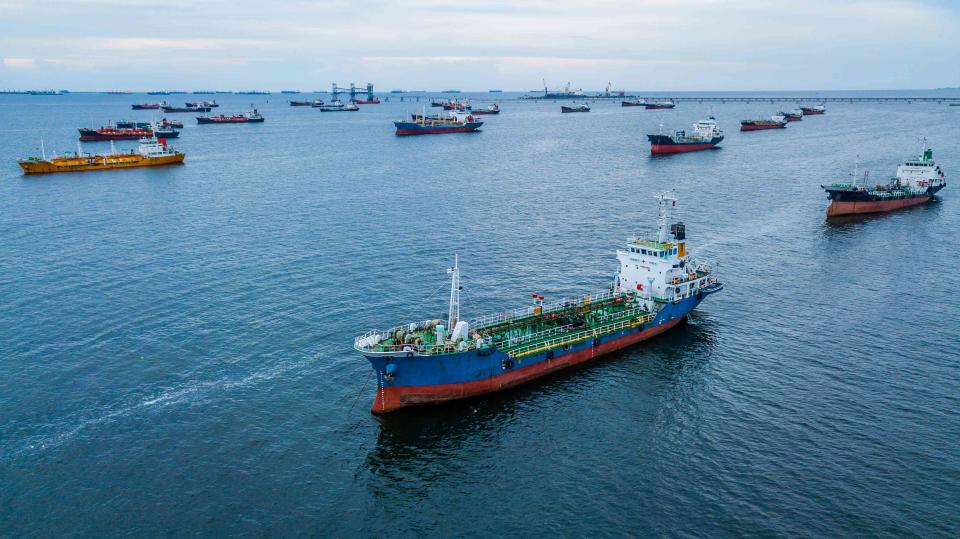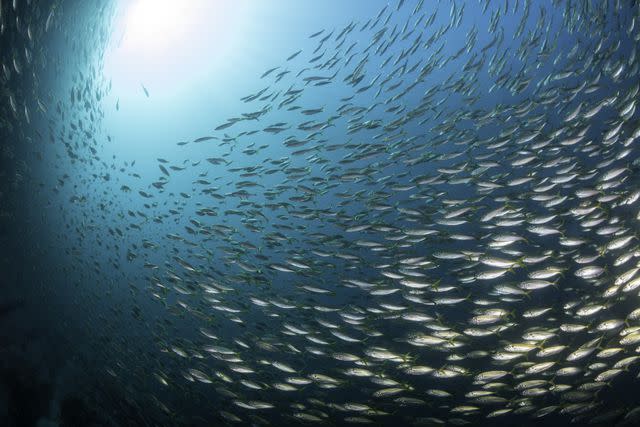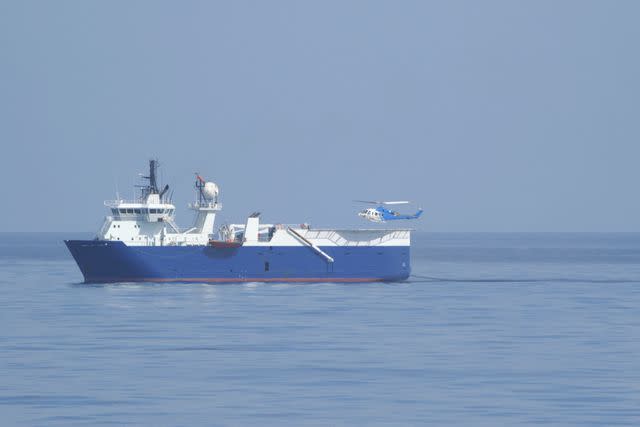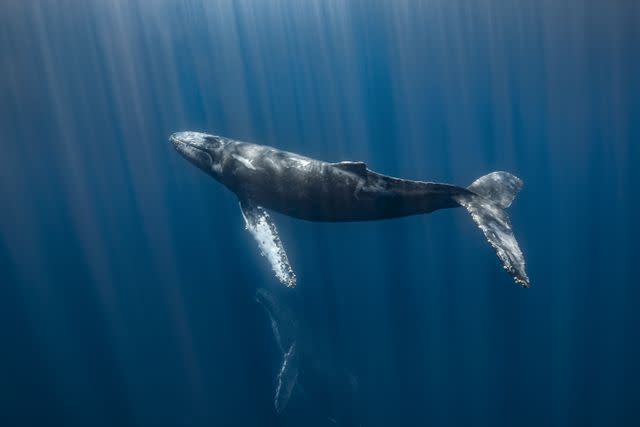The Environmental Impact of Ocean Noise
Ocean noise pollution can extend beyond individual animals to impact entire ecosystems. Here are the facts and how you can help.

Ocean noise broadly refers to the noise made by human activity that can obstruct the ability of marine animals to hear natural sounds in the ocean. Anthropogenic noise has been increasing over the years, even doubling each decade in some areas of the world. This noise can mask communication between aquatic animals and decrease their ability to find prey or be aware of predators, among other problems. This type of noise pollution can impact individual species from disturbance to mortality if not controlled.
Ocean Noise Pollution Facts
Sources of human-made ocean noise pollution include shipping vessels, sonar systems, seismic surveys, military exercises, and underwater construction.
The intensity of ocean noise has increased dramatically over the past few decades due to the expansion of commercial shipping, offshore drilling, and other human activities.
Marine mammals rely heavily on sound for communication, navigation, and finding food. Excessive noise can disrupt their behavior and cause stress, injury, or even death.
Ocean noise pollution can also impact fish and invertebrates, affecting their ability to communicate, locate prey, and avoid predators.
Research and monitoring efforts are ongoing to understand the impacts of ocean noise pollution better and develop effective strategies for its reduction.
What Is Ocean Noise?
Ocean noise can cause changes to the acoustic environment and adds increased stressors for marine life. Ocean noise can be sounds of low, medium, or high frequencies and is attributed to many different types of equipment. This noise can also cause habitat loss and can extend migration routes if it is too disturbing.

Marine life may also be indirectly affected if they stay, but their prey leaves the area because of noise disturbance. Some of the effects monitored in ocean life include stress, weak immune systems, and behavioral disturbances.
Read Next: Noise Pollution Is Coming for the Narwhals
Seismic Surveys
The type of equipment and practices that can affect marine life include seismic surveys, which use loud air guns. The sound can be generated every 10 seconds and can raise noise levels 100 times for days on end within a range of 300,000 square kilometers.

On any given day, there are more than 20 seismic survey ships active worldwide used to conduct surveys for the oil and gas industry.
Marine life can be killed directly by this noise as well as cause internal injuries to animals like the giant squid. There has been evidence of mass whale strandings because whales were injured internally or through their hearing-related structures.
Impulsive Sound
Another source of problematic noise pollution is impulsive sound—sudden and short-duration sounds that are typically high in intensity and range from low to high frequencies. These are generally used in construction or marine civil engineering. The sound can reach up to 100 kiloHertz, and it can repeat every 10 to 15 seconds.
Sonars are included within impulsive sound but can be separated into different types of sonar. Low-frequency active sonars are usually used by the military and can generate between 100 to 500 Hertz.
Acoustic Deterrent Devices produce impulsive sound, which is used in an effort to reduce bycatch. These devices emit pulses of high-frequency sound and may be used to deter cetaceans from approaching fishing gear or to keep pinnipeds away from fish farms. These devices can produce sound with a frequency between 5 and 160 Hertz—though the intentions may be good, the noise can inflict pain on their target species, as well as unintended species.
Explosives
Explosives produce the highest level of noise. Controlled explosives may be used in underwater construction projects, such as the demolition of old structures like oil platforms, bridges, or underwater obstacles. Explosives may also be utilized for military purposes in naval warfare and defense. Underwater explosions can cause immediate and long-term harm to marine life.
Effects of Ocean Noise on Marine Life
Many species of marine life use noise as a means of survival. Some marine animals use calls during procreation or spawning, fish larvae follow sound to find a place to settle, and certain whales use echolocation to orient themselves or find food. Following are just some cases of animals that have been directly affected by ocean noise.

Whales
Researchers studying humpback whales in Glacier Bay National Park, United States, documented the effects of high noise exposure from tourism vessels. In competition with these vessels, the whales increased the amplitude of their voice by 0.8 decibels with every 1.0 decibel increase in ambient noise. However, they also vocalized less frequently.
Meanwhile, a 2028 study looking at humpback whales in Japan's Ogasawara Islands observed that the whales stopped vocalizing altogether when a cargo vessel passed within 1,400 meters, ununderscoring yet again how noise pollution can negatively impact these marine life.
Fish
Sound can be detected in two sensory systems in fish, with one system based on water motion and low frequency and the other being a frequency-dependent hearing system. Fish can, in general, hear best between frequencies of 30 to 1000 Hertz. When observing settling patterns in fish, many species use sound to orient themselves. One study found that damselfish that were conditioned to artificial noise actually became attracted to the noise, while those that were conditioned to noise from coral reefs avoided artificial noise. The authors concluded that artificial noise can cause confusion in animal species and disrupt orientation, and in doing so, could weaken the population.
Zooplankton
Microscopic zooplankton can be killed by the noise from a single seismic airgun. Zooplankton provides a source of food for the whole ocean ecosystem, but researchers have observed that airgun activity can reduce the number of zooplankton by half, which causes a lack of source of food for marine life. In the study, all immature krill were killed, and some zooplankton species decreased in number above 95%. This impact was observed up to 1.5 hours after the airgun had passed—note that most seismic surveys employ 18 to 48 airguns.
What Can Be Done?
The only certain way to lower the risk of impact is noise abatement—as in, reducing the amount of noise pollution entering the marine environment in the first place. This can be achieved by reducing noise emitted at the source, and by reducing the amount of noise-generating activity.
A study looking at noise abatement set out to determine the best twat o design noise abatement measures, concluding that, "broadly speaking, policy measures to manage environmental pollution can be categorised as command-and-control (CAC) approaches or incentive-based measures (IBMs), also known as market-based measures." CAC approaches would come in the form of mandatory measures. IBMs include cap-and-trade scenarios, "where transferable pollution permits are traded among polluters (affording control over cumulative pollution levels via the total number of permits), or through economic incentives, which encourage pollution reduction through subsidies or taxes linked to emissions."
The authors conclude: "As climate change and increasing human use of the oceans put growing strain on marine ecosystems, noise abatement presents a relatively tractable policy option to help reduce the cumulative burden of anthropogenic pressure on Earth’s marine habitats."

How Can You Help Reduce Ocean Noise Pollution
Raise awareness: Educate yourself and others about the harmful effects of ocean noise on marine life.
Reduce personal noise: Minimize the noise you make when boating or participating in water activities.
Choose quieter watercraft: If you own a boat or personal watercraft, opt for quieter models with noise-reducing features. Consider electric or hybrid engines, which produce less noise and emissions.
Buy locally! Reducing your dependence on items shipped on cargo ships from overseas helps lessen your personal ocean-noise footprint.
Promote responsible fishing practices: Encourage sustainable fishing practices that minimize the use of loud equipment and engines.
Support marine protected areas: Advocate for the creation and expansion of marine protected areas to provide safe havens for marine life and reduce impacts from human activities.
Support organizations working on noise reduction: These groups often engage in research, advocacy, and policy work to protect marine environments.
Support regulations and policies: Stay informed about local and international regulations related to ocean noise pollution. Support initiatives that aim to regulate and mitigate noise from shipping, offshore construction, and other industrial activities.
Related: Over 5,000 New Deep-Sea Species Found in Future Mining Hotspot
Read the original article on Treehugger.

